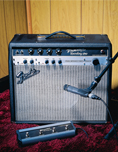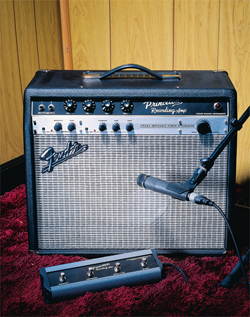Fender Princeton Recording-Amp combo


VINTAGE TUBE FENDER Princeton and Princeton Reverb combos are the stuff of studio legend. These low-watters were intended as upscale practice amps for guitarists who thought the Fender Champ too basic, but they found their way into studios because they sounded big and loud, at levels recording engineers could live with.
The Princeton name eventually got co-opted for a line of solid-state amps that were designed to be portable and affordable. With the new Princeton Recording-Amp, Fender has not only returned the amp to its tube origins but also enhanced its feature set for studio use.
FEATURES
SPORTING MINIMAL CONTROLS and a tube-driven spring reverb, the Princeton Recording-Amp uses a pair of 6V6 power section to push 20 watts of tube tone from its 10-inch Jensen C-10R speaker. If this were the end of the story, the Princeton would be a straightforward vintage-style tube combo.
But the new Princeton has modern features, too, including a built-in compressor, an overdrive circuit, the D.I. recording outputs (which have speaker emulation), and the Trans-Impedance Power Attenuator, which lets the power section churn out gain-heavy tone at low volumes. There is even an effect loop, which was lacking on the original vintage hardware.
The combo's front panel controls are divided into two sections. The top panel has traditional controls-volume, treble, bass and reverb level-and inputs 1 and 2, for guitars with standard and hot pickups, respectively. The lower control panel gives you command over the Princeton's compressor, overdrive and Trans-Impedance Power Attenuator circuits (more on this last item below). The compressor has an on switch and controls for sensitivity and level; the overdrive has an on switch and controls for overdrive, tone and level. Both are effective additions: the former adds sustain and drive and lets you dial up a countrified tone, while the latter reminds me a bit of a Tube Screamer, adding edge and grit without getting too fuzzy. Each section can be activated by the included footswitch, as can the reverb and effect loop.
The rear panel features speaker and headphone outputs, an XLR line output with a level control and ground lift, effect loop connections and a multipin jack for the included footswitch. The effect loop is especially welcome because it gives you the option of using processors like delay post gain, something preferred by most modern players.
TRANS-IMPEDANCE POWER ATTENUATOR
THIS IS EASILY the Princeton's coolest feature, allowing you to create huge sounds while maintaining low output volumes. It couldn't be easier to employ: use the amp's volume control to dial up progressive amounts of whole-amp gain, ranging from clean sounds to smoking blues tones; then, use the attenuator's oversized knob to set the amp's output level.
Get The Pick Newsletter
All the latest guitar news, interviews, lessons, reviews, deals and more, direct to your inbox!
With vintage nonmaster-volume amps like the original Princeton, you still have to move some air to get the power tubes to sing, and while this may be fine in a recording studio, it's usually too loud for recording in an apartment. The power attenuator circuit is the solution to the latter problem and makes the Princeton sound much creamier than a typical master-volume amp, which relies on preamp overdrive and doesn't saturate the power tubes at lower volumes. Here, the preamp and power section work together to create thick tone syrup, sculpted by the tone controls.
PERFORMANCE
THOUGH IT'S CAPABLE of a range of tones, the Princeton Recording-Amp is not designed to cram the sound of every amp ever made within its compact frame. It has an identity of its own.J
In action, the Princeton did more than impress: it inspired, too. Free from the complexity of a modern amp's control panel, I just dialed in a baseline tone, plugged in my Tele and started wailing. The amp was plenty loud enough to compete with bass and drums. My favorite setting was with the volume up a little less than full; from there, I used the Tele's volume knob to go from clean to nasty, adding a little grit with the treble knob. The compressor and overdrive are both worthy additions, but the amp's pure tone was a blast without them.
THE BOTTOM LINE
LIKE A TASTEFULLY updated vintage Porsche, the Princeton Recording-Amp marries what's great about the old days with the utility of the modern age. The result is great tone that is accessible equally onstage and in the studio.

![A black-and-white action shot of Sergeant Thunderhoof perform live: [from left] Mark Sayer, Dan Flitcroft, Jim Camp and Josh Gallop](https://cdn.mos.cms.futurecdn.net/am3UhJbsxAE239XRRZ8zC8.jpg)







